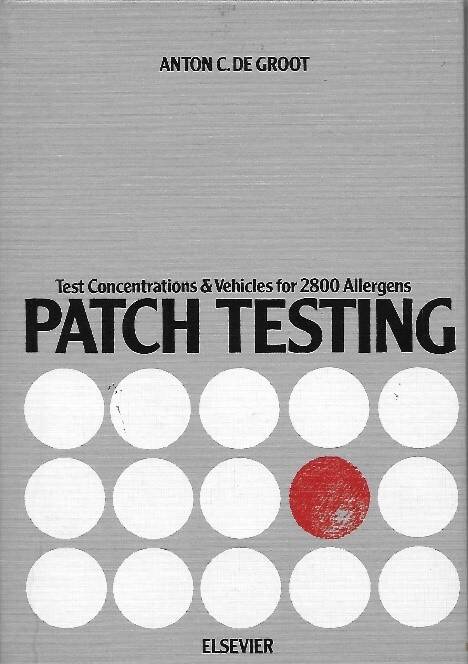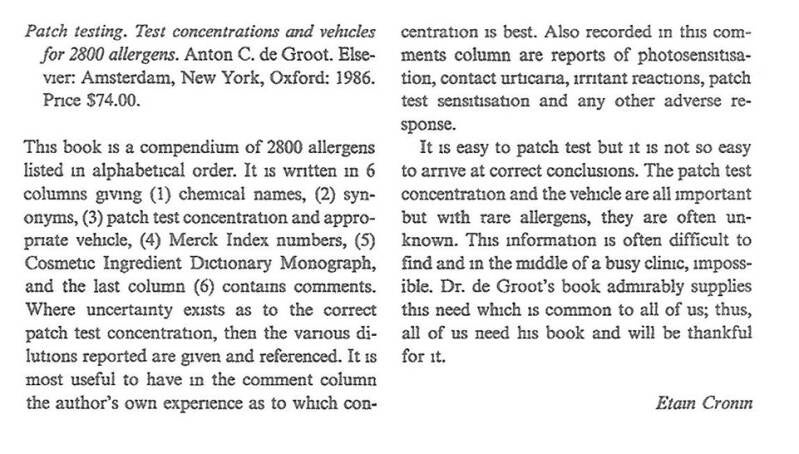Patch testing first edition

In 1984 I started writing the first edition of Patch testing. What helped is that I bought a personal computer for my practice that year. It was one of the first shipments in the Netherlands of the IBM XT or AT, one of the first 'real' personal computers after the Commodores, which were more like gaming computers. I'll tell you more about that here. Read and shudder!
I had bought some (Grote Beer) software with the computer, including a D-base program. For each allergen I entered several data in a separate file: name of the substance, synonyms, test concentrations, vehicles, the literature sources for this, whether the substance was commercially available for patch testing and a few other data. My intention was to print all those files alphabetically in a large table and I succeeded! The program's alphabetizing system was, of course, clunky, but what can you expect from software programs from more than 35 years ago? For example, I had to place the prefixes such as numbers (1,3-, 2,4,6-, etc.) and chemical designations such as sym-, dl-, L-, α-, β-, γ-, cis-, trans-, etc. after the name, because otherwise 1,1-Zonalone would be placed at the very front instead of at the Z. And spaces
between words also caused problems, for example benzyl salicylate (with space) ended up before benzylcinnamate (without space). In the end I unfortunately had to number all 2800 files manually in a separate column, print them out by number, but not have the numbers themselves printed. It was often quite difficult and hard, in the pre-modern computer era …….. (by the way, is still is every now and then).

So, now I was able to print out almost the entire book and deliver it 'camera ready', as it was called at the time (1985). Elsevier had already promised to publish the book and on a bright sunny day (read further why that day was or at least became so sunny) I went from 's-Hertogenbosch to Amsterdam with a print-out of part of the book as a surprise. And that was it! And they were wildly enthusiastic, the people of Elsevier, because they had never seen this before. And then one of the board members of Elsevier made a tactical error by exclaiming in her enthusiasm 'That saves us 200 guilders per page'. My brain rattled for a moment and within 2 seconds I said 'That's great, then you can give me half of that'. I had discovered my business side! And, believe it or not, I received an amount of Fl. 30,000 (thirty thousand guilders), about 14,000 euros. And all of this in 1985!
As the book reviews (only some examples given) below show, the reviewers were as enthusiastic as the publisher and my name on the international scene of dermatoallergology, which had already taken some root through my book Unwanted effects of cosmetics and drugs used in dermatology, was forever established.

Book reviews of the first edition of Patch testing (selection)
Contact Dermatitis 1987;16:180

British Journal of Dermatology 1987;116:142-143
Patch Testing: Test Concentrations and Vehicles for 2800 Allergens. A.C. de Groot (1986) Amsterdam: Elsevier. Pp. 295. Price $74.00.
This will prove to be a very useful tool for dermatologists who work in the patch test clinic. It will frequently save extensive searching of the literature to find patch test concentrations of chemicals with which one is unfamiliar. This is particularly helpful when testing for sensitivity to individual cosmetic or medicament ingredients or unknown industrial compounds. …….. Overall, this is an extremely useful patch testing aid and one which I am sure will be widely used.
J.D.WILKINSON
Clinical and Experimental Dermatology 1987;12:389
…… Any criticisms of Patch Testing are minor. It must be seen as a work of importance in helping the proper performance of patch testing, although the interpretation of results only comes with experience. Once again de Groot has made a significant contribution to the dermatological literature on contact dermatitis, and his present work should be sought after by any dermatologist who employs patch-test techniques.
I.R. WHITE
Archives of Dermatology 1988;124:1135
…..Alphabetical listing and extensive cross-referencing make it quite easy to find information in this volume. This book will certainly be a time saver in finding patch-test recommendations for uncommonly encountered contact allergens, and it may prove to be a worthwhile investment for dermatologists who frequently perform patch testing.
MICHAEL BIGBY
Dermatosen in Beruf und Umwelt 1987;35:Heft 4
……Dieses Buch erscheint für jeden Arzt unentbehrlich, der Epikutantests durchführt, da es auch durch die weiterführende Literatur entscheidende Hinweise für die tägliche Arbeit bietet. Der Preis ist relativ hoch, jedoch im Hinblick auf den Praktischen Wert angemessen.
HELMUT IPPEN
Annales de Dermatologie et Vénéreologie 1987;114 :475
….Tous ces renseignements permettront sans aucun doute d’approfondir et de diagnostiquer de façon plus précise les allergies de contact.
A. PONS

